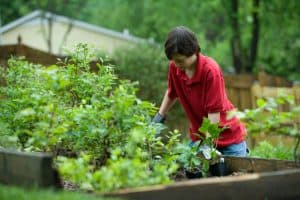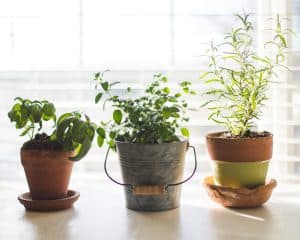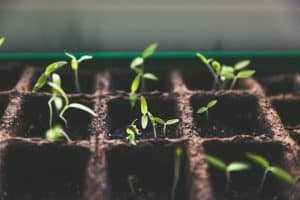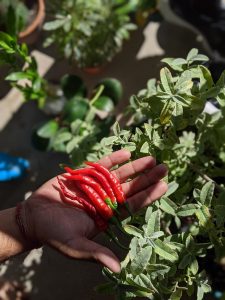Welcome to our comprehensive guide on successful container gardening! If you have a small space but a big desire to grow your own fresh vegetables, you’ve come to the right place. In this blog post, we’ll delve into vegetable combination ideas for container gardens that will not only save space but also provide you with a bountiful harvest.
We’ll explore everything from choosing the right containers and soil to selecting the perfect vegetable combinations. Whether you’re a seasoned gardener or just starting, these tips will help you create a flourishing container garden that’s both beautiful and productive.
Choosing the Right Container

Choosing the right container is your first step toward a successful container garden. Large containers are an excellent choice, as they provide ample space for most vegetables. However, if you’re dealing with a small space like a balcony or windowsill, there are creative solutions available. Traditional garden pots are a reliable choice, and their variety of sizes and materials make them versatile.
For a touch of uniqueness, consider repurposing old wine crates or opting for decorative window boxes. These can add a charming aesthetic to your garden while maximizing your space. Whichever container you choose, ensure it has proper drainage holes to prevent waterlogged soil, especially essential for moisture-sensitive crops like leafy greens or spinach.
Expert Tip: If you’re using hanging baskets, make sure they are sturdy and well-supported to handle the weight of the soil and plants.
Essential Soil and Fertilizer
Your container’s soil quality is paramount to your vegetable garden’s success. Container plants rely on the soil within their confined space, so choosing the right potting mix is essential. Look for a high-quality potting soil mix that is specifically designed for containers. These mixes are well-draining and typically contain the right blend of organic matter and nutrients to support plant growth.
To retain soil moisture and keep your vegetable plants healthy, consider adding water-retaining polymers to the soil. These can be especially useful if you live in a region with hot, dry summers. Additionally, choose a slow-release or organic fertilizer to ensure a consistent supply of nutrients throughout the growing season.
Authoritative Advice: Be cautious with over-fertilizing, as it can lead to excessive vegetative growth at the expense of fruit production.
Selecting Vegetables for Containers

Container vegetable gardening is a versatile and exciting way to grow a wide range of vegetables, herbs, and even ornamental plants in limited spaces. Here, we’ll explore the incredible diversity of plants that thrive in containers and how to make the most of your small gardening area.
1. The Vegetable Spectrum
Container gardens allow you to grow almost any vegetable you desire, provided you choose the right varieties and sizes. Some popular choices for container gardening include:
- Tomatoes: Ideal for larger containers or sturdy cages, tomatoes come in many compact varieties suitable for containers. Cherry tomatoes are particularly well-suited for hanging baskets.
- Peppers: Bell peppers, chili peppers, and sweet peppers can flourish in containers. They offer colorful fruits and are perfect for adding a dash of spice to your dishes.
- Herbs: Herbs like dill, fennel, basil, and Thai basil are well-suited for containers due to their compact growth habits and aromatic foliage.
- Leafy Greens: Lettuce, spinach, kale, and Swiss chard thrive in containers, especially if you prefer fresh salads straight from your garden.
- Radishes: These fast-growing root vegetables are perfect for containers, and you can harvest them in as little as three weeks.
2. Plant Types for Small Spaces
If you have limited space, consider these strategies:
- Vertical Gardening: Vertical gardening is an excellent solution for small spaces. Use trellises, stakes, or even a simple tomato cage to encourage plants like cucumbers and pole beans to grow upward, saving valuable ground space.
- Companion Planting: Selecting companion plants strategically can enhance your garden’s productivity. For instance, planting marigolds near tomatoes can help deter aphids and nematodes, while basil planted alongside tomatoes can improve their flavor and deter common pests like tomato hornworms.
3. Aesthetics in Your Container Garden
Your container garden can be a feast for the eyes as well as the palate. Consider adding edible flowers and plants with attractive foliage to make it visually appealing:
- Edible Flowers: Flowers like nasturtiums, violets, and pansies are not only beautiful but also edible. They can be used to garnish salads or desserts.
- Attractive Foliage: Plants like purple basil, ornamental kale, and variegated sage bring vibrant colors and interesting textures to your container garden.
4. Container Versatility
Containers come in various forms, each offering unique advantages:
- Hanging Baskets: Hanging baskets are perfect for cascading plants like cherry tomatoes or trailing herbs. They save floor space and add a touch of elegance to your garden.
- Colorful Pots: Vibrant and colorful pots not only provide a suitable environment for your plants but also contribute to the overall aesthetics of your garden. Choose pots that complement the colors of your vegetables and herbs.
Vegetable Combination Ideas
Here, we dive into the heart of container gardening – vegetable combination ideas. Imagine a “Salsa Garden” where tomatoes, peppers, onions, and cilantro coexist harmoniously, ready for homemade salsa. Or picture a “Salad Bowl” bursting with lettuce, spinach, radishes, and a medley of herbs for daily fresh salads. These combinations not only save space but also create visually appealing and functional gardens.
When planning your container garden, consider the concept of companion planting. For instance, marigolds can help deter aphids and other pests when planted near tomatoes. Basil enhances the flavor of tomatoes and peppers while repelling common garden pests.
Don’t forget about vertical gardening. Growing vertically, whether using stakes, trellises, or cages, allows you to maximize space and increase your yield. For example, cucumbers and pole beans thrive when they can climb upwards.
Expertise Matters: Success in container gardening is about understanding your plant’s needs and tailoring combinations accordingly. This knowledge comes with experience, but with the right guidance, even beginners can achieve stunning results.
Care and Maintenance

Watering: The Lifeline of Your Container Garden
Watering your container garden is a bit of an art. It’s essential to strike the right balance between keeping your plants well-hydrated and avoiding overwatering, which can lead to root rot. Here’s how to approach it:
1. Consistency is Key: Different plants have varying moisture requirements. For instance, leafy greens like spinach and herbs generally thrive when kept consistently moist. They prefer soil that is evenly moist but not waterlogged. On the other hand, tomatoes and some other vegetables prefer slightly drier conditions between watering to prevent fungal diseases.
2. Watering Schedule: Establish a regular watering schedule based on the needs of your plants. Check the soil moisture by inserting your finger about an inch into the soil. If it feels dry at that depth, it’s time to water. Aim to water in the morning to give your plants ample time to absorb moisture before the heat of the day.
3. Drainage is Vital: Ensure your containers have adequate drainage holes to allow excess water to escape. Use well-draining potting mix to prevent water from pooling at the bottom of the container.
4. Mulching: Consider adding a layer of mulch on top of the soil. Mulch helps retain moisture, reduce evaporation, and regulate soil temperature.
Sunlight: Fuel for Growth
Sunlight is the primary source of energy for plants through photosynthesis. Understanding your plant’s sunlight requirements is crucial for their health and productivity:
1. Sunlight Duration: Most vegetables, including tomatoes, peppers, and cucumbers, thrive in full sun, which means they need at least 6 hours of direct sunlight daily for optimal growth and fruit production. Ensure your containers are placed in a location where they receive adequate sunlight.
2. Shading: In extremely hot climates, some plants may benefit from partial shade during the hottest part of the day. Consider using shade cloth or strategically placing containers to provide relief from intense sun.
Pruning and Staking: Shape and Support
Pruning and staking are techniques to encourage healthy growth and manage the size and shape of your plants:
1. Pruning: Regularly remove dead or yellowing leaves and any spent flowers. This not only keeps your plants looking tidy but also redirects energy toward new growth and fruit production. Be cautious not to prune excessively, as some plants may need their foliage for protection from the sun.
2. Staking: Tall or vining plants like tomatoes, peppers, and beans often benefit from staking or trellising. This helps them stay upright, reduces the risk of disease by keeping the foliage off the ground, and makes harvesting easier.
Beneficial Insects: Nature’s Pest Control
Encouraging beneficial insects to visit your container garden can be a game-changer for pest control and pollination:
1. Pollinators: Bees, butterflies, and other pollinators are essential for fruit-bearing plants like tomatoes and cucumbers. Planting flowers nearby or in your containers can attract these valuable insects.
2. Predators: Ladybugs, lacewings, and parasitic wasps are natural predators of harmful garden pests like aphids and caterpillars. Avoid using chemical pesticides that harm these beneficial insects.
Enjoying Your Container Garden

The best part of container gardening is the joy that comes from enjoying the fruits (and veggies) of your labor. It’s the moment you’ve been patiently waiting for, and it’s the culmination of your efforts. Here, we’ll dive deeper into how to make the most of this rewarding phase of your container garden journey.
Harvesting at Peak Ripeness:
Harvesting your vegetables at the right time is crucial to savoring their full flavor and nutritional value. Each vegetable has its own cues for when it’s ready to be plucked. For instance, tomatoes should be harvested when they are fully colored and slightly soft to the touch, signaling their peak ripeness. On the other hand, leafy greens like spinach should be harvested when the leaves are young and tender, ensuring the best taste and texture.
Delicious Recipes for Homegrown Produce:
To truly celebrate your homegrown bounty, we’ll share a selection of mouthwatering recipes that maximize the flavors of your container garden. Imagine whipping up a classic Caprese salad, where you can showcase the vibrant colors and flavors of your freshly picked tomatoes and basil. Or perhaps a garden-fresh stir-fry featuring peppers, onions, and other veggies from your containers. These recipes not only allow you to enjoy the freshest ingredients but also showcase your culinary skills.
Creating a Welcoming Space with Garden Decor:
To enhance the experience of savoring your container garden’s harvest, consider adding a touch of garden decor to your outdoor space. Whether it’s a cozy seating area with colorful cushions or decorative pots that complement your containers, these small touches can transform your garden into a welcoming oasis. Imagine dining amidst the lush greenery of your container garden, under the gentle sway of hanging baskets, with a sense of pride and contentment.
Container Vegetable Garden Ideas for Variety

Container gardening isn’t just about practicality; it’s also an opportunity to infuse your space with creativity and color. When planning your vegetable container garden, consider mixing and matching colorful vegetables to create a visually stunning display. Opt for vibrant peppers in shades of red, yellow, and green, along with the deep purples of eggplant. These colorful vegetables not only provide a visual feast but also pack a flavorful punch.
To further enhance the aesthetics, choose containers that are as colorful as your vegetables. Decorative pots and glazed containers come in an array of hues, adding an artistic touch to your garden. By combining colorful vegetables with equally colorful containers, you can transform your small gardening space into a captivating focal point.
Growing Fresh Herbs in Your Container Garden
One of the joys of container gardening is having easy access to fresh herbs right outside your door. Herbs like basil, oregano, and thyme are not only flavorful additions to your dishes but also beautiful, fragrant plants that can thrive in containers. Planting them alongside your vegetables is not only practical but also adds an aromatic dimension to your garden.
To ensure your herbs flourish, use high-quality garden soil enriched with organic matter. Herbs appreciate well-draining soil and will reward you with a continuous supply of fresh, aromatic leaves throughout the growing season. Whether you’re garnishing your meals or making herbal teas, having fresh herbs at your fingertips elevates your culinary experience and adds a touch of elegance to your container garden.
Final Thoughts: Vegetable Combination Ideas for Container Gardens
In conclusion, container gardening offers a world of possibilities for those with limited space or a desire for convenience. With the right containers, soil, and vegetable combinations, you can grow a diverse range of produce right at your doorstep. Whether you opt for large containers or small ones, the key is to save space while growing your favorite vegetables. So, get creative with your container garden, and you’ll be rewarded with a bountiful harvest and a delightful gardening experience.
Remember, successful container gardening is within your reach, no matter your level of expertise. Start your container vegetable garden today and enjoy the pleasures of homegrown vegetables, herbs, and more!


